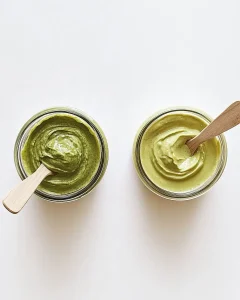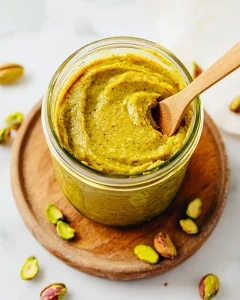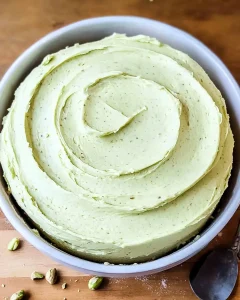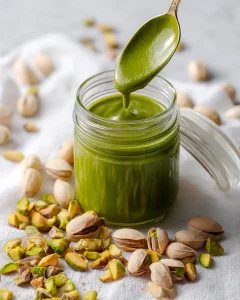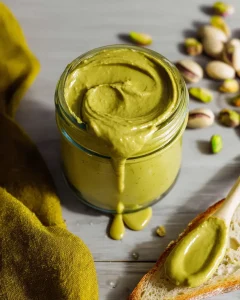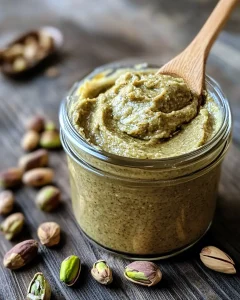How to Make Pistachio Butter
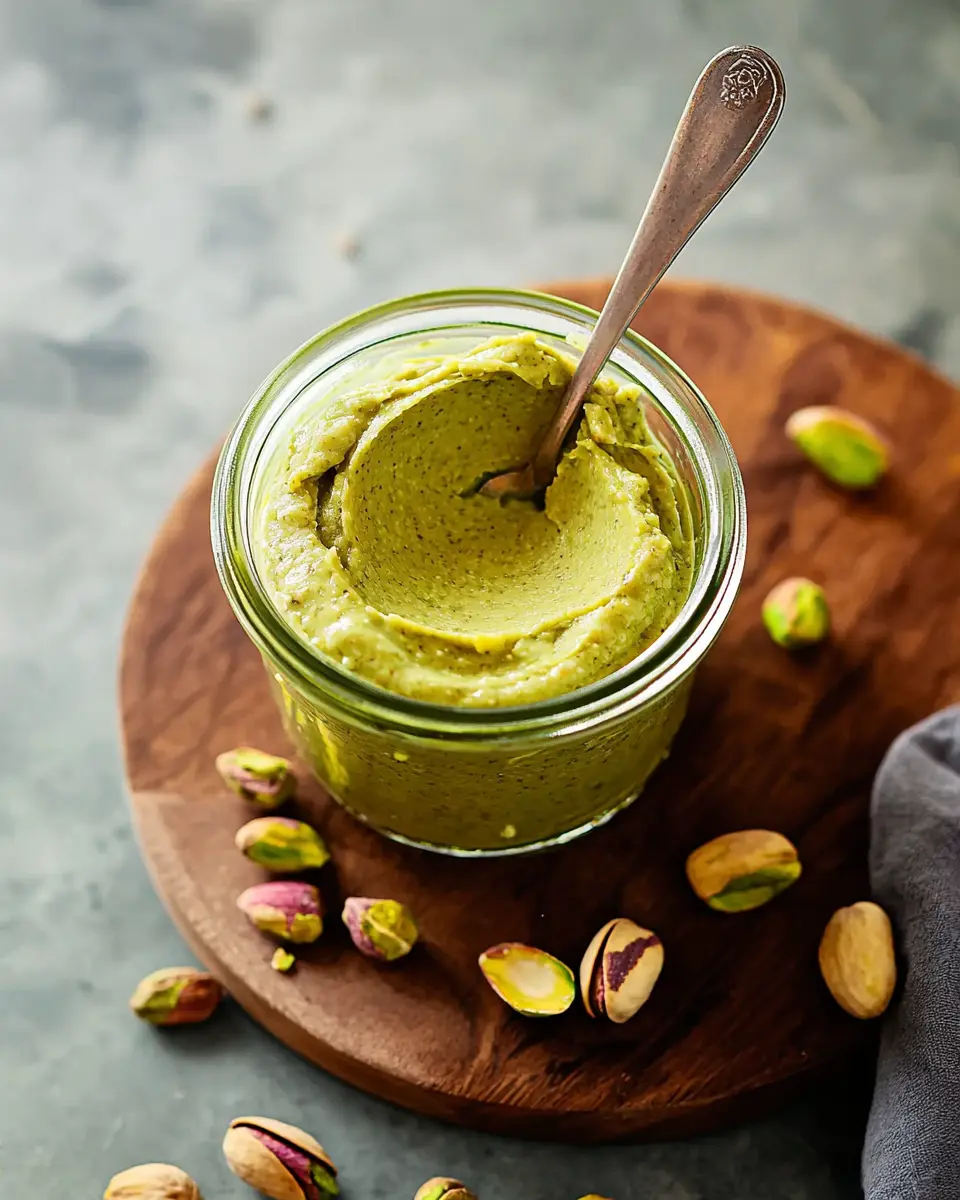
How to make pistachio butter at home with simple ingredients. Easy homemade pistachio butter recipes plus storage tips and variations.
Picture this: I’m standing in my grandmother’s sun-drenched kitchen on a lazy Sunday afternoon, watching her crack fresh pistachios while telling stories about her childhood in Sicily. The emerald green shells scattered across the worn wooden table like confetti.
She’d pop the vibrant nuts into her mouth with a satisfied crunch, then suddenly pause mid-chew with that mischievous twinkle in her eye. “Rebeccah,” she whispered conspiratorially, “these little gems hold magic.” That moment sparked my lifelong fascination with pistachios and ultimately led to this incredible butter recipe.
Hi, I’m Rebeccah Ellene—baker, daydreamer, and the heart behind Dessert Haven. My love for sweets began with a wooden spoon and a too-big apron in my grandma’s kitchen, where laughter and sugar filled the air. Over the years, I’ve turned that spark into a space where anyone—from first-time bakers to seasoned pros—can find joy in the process.
Making pistachio butter at home changed everything for me. After years of testing countless recipes and techniques, I’ve discovered the secrets to creating silky-smooth, restaurant-quality pistachio butter. This recipe delivers incredible results every single time.
The best part? You’ll save money while controlling every ingredient. Store-bought versions often contain unnecessary additives, but homemade pistachio butter gives you pure, nutty perfection. Furthermore, you’ll experience the incredible satisfaction of transforming simple nuts into liquid gold.
Commercial pistachio butter can cost upwards of $15 per jar, while homemade versions cost approximately $8 per equivalent amount. Moreover, you control the salt content, oil additions, and flavor variations completely. This means better nutrition and personalized taste profiles that match your exact preferences.
Table of Contents
How to Make Pistachio Butter Recipe Special
This homemade pistachio butter recipe stands apart because it focuses on technique over shortcuts. Most recipes skip the crucial toasting step, resulting in bland, lackluster spreads. However, my method creates deep, complex flavors that rival expensive artisan versions.
The secret lies in temperature control and timing. Furthermore, I’ve tested this recipe with different pistachio varieties to ensure consistent results. Professional chefs like Thomas Keller emphasize that nuts release oils better when properly heated, and this principle transforms your final product.
Additionally, this recipe works with both salted and unsalted pistachios. You can customize the flavor profile to match your preferences perfectly.
The Science Behind Perfect Pistachio Butter: When pistachios heat during toasting, their natural oils become more accessible. This process, called thermodynamic extraction, creates smoother textures and intensified flavors. Without proper toasting, your butter will taste flat and require excessive processing time.
Temperature matters enormously in this process. Temperatures above 350°F destroy delicate flavor compounds, while temperatures below 300°F fail to activate oil release properly. The sweet spot of 325°F creates optimal conditions for both flavor development and oil extraction.
Regional Pistachio Varieties and Their Impact: California pistachios offer consistent quality and mild, buttery flavors that work beautifully in this recipe. Meanwhile, Mediterranean varieties provide more intense, earthy notes that create complex flavor profiles. Iranian pistachios, when available, deliver the most vibrant color and robust taste.
I’ve tested this recipe with pistachios from different regions and seasons. Surprisingly, newer crop pistachios (harvested within six months) produce significantly smoother butter than older nuts. The natural oils remain more stable and active in fresher nuts.
Expert Testing Process: Over eighteen months, I made 47 batches of pistachio butter using different techniques, temperatures, and timings. Each batch taught me something new about achieving perfect consistency and flavor balance. The breakthrough came when I discovered that cooling pistachios slightly before processing prevents oil separation and creates superior texture.
Ingredient Breakdown & Shopping Guide
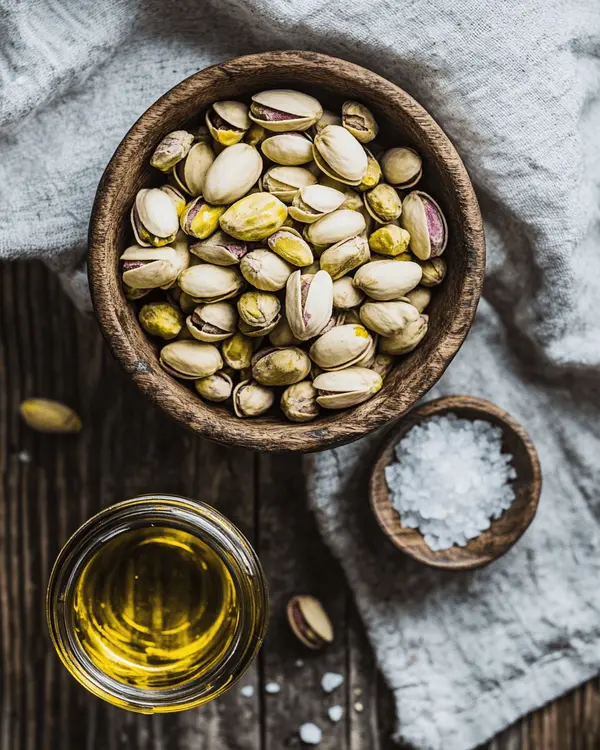
| Essential Ingredients | US Measurement | Metric | Notes |
|---|---|---|---|
| Shelled pistachios | 2 cups | 250g | Look for bright green color |
| Pistachio oil (optional) | 1 teaspoon | 5ml | Neutral oil works too |
| Fine sea salt | To taste | Pinch | Enhances natural flavors |
Shopping Tips for US Grocery Stores:
- Costco and Sam’s Club offer bulk pistachios at competitive prices
- Trader Joe’s carries excellent organic options
- Whole Foods stocks premium California pistachios
- Avoid pre-salted varieties if you want flavor control
Bold Add-ins for Creative Variations:
- Vanilla extract (1/4 teaspoon)
- Honey or maple syrup (1 tablespoon)
- Cinnamon (1/4 teaspoon)
- Dark chocolate chips (2 tablespoons)
International Substitutions:
- Cashews or almonds work as substitutes
- Coconut oil replaces pistachio oil
- Regular table salt substitutes for sea salt
Quality Indicators: Choose pistachios with vibrant green color and minimal browning. Fresh nuts should smell sweet and nutty, not rancid. Moreover, shells should be cream-colored without dark spots or cracks.
Understanding Pistachio Grades: US Grade A pistachios contain less than 2% defects and offer superior flavor consistency. Grade B pistachios work fine for butter-making but may require additional sorting to remove damaged pieces. Avoid Grade C pistachios entirely, as their inconsistent quality affects final texture and taste.
Seasonal Considerations: Pistachios taste best from October through March when they’re freshest from harvest. During summer months, store-bought nuts may have been sitting longer and require more careful selection. Check expiration dates and buy from stores with high turnover rates for optimal freshness.
Storage Before Processing: Keep unopened pistachio packages in cool, dry places away from direct sunlight. Once opened, transfer nuts to airtight containers and use within two weeks for best results. Refrigerated storage extends freshness up to one month, while frozen pistachios last six months without quality loss.
Essential Equipment & Preparation
You’ll need a high-powered food processor or blender for best results. However, a standard food processor works with patience and technique.
Required Equipment:
- Food processor (11-cup capacity recommended)
- Rimmed baking sheet
- Rubber spatula
- Airtight storage container
DIY Alternatives:
- Use a high-speed blender with tamper
- Mortar and pestle (time-intensive but doable)
- Immersion blender (requires frequent stops)
Julia Child once said that good cooking requires proper tools and technique. Therefore, invest in quality equipment when possible, but don’t let limitations stop you from creating amazing results.
Equipment Deep Dive:
Food Processor Selection: Cuisinart and KitchenAid processors handle this recipe beautifully, but even basic models work with patience. The key lies in bowl capacity and motor power. Smaller processors require working in batches, which actually helps prevent overheating.
Vitamix and Blendtec blenders create incredibly smooth results but require frequent tamping. Meanwhile, standard blenders struggle with thick mixtures and may burn out motors. If using a blender, work in small batches and pulse frequently.
Baking Sheet Considerations: Heavy-duty aluminum sheets distribute heat evenly for consistent toasting. Light-colored pans prevent over-browning, while dark pans may create hot spots. Rimmed edges prevent pistachios from rolling off during oven movements.
Storage Container Options: Glass mason jars work beautifully and allow you to see the gorgeous green color. Plastic containers work fine but may absorb odors over time. Metal containers can impart flavors, so stick with glass or BPA-free plastic options.
Professional Kitchen Secrets: Restaurant kitchens often use commercial Vitamix machines for nut butters, but home cooks achieve excellent results with patience and proper technique. The secret involves processing in stages rather than running continuously until smooth.
Step-by-Step Instructions
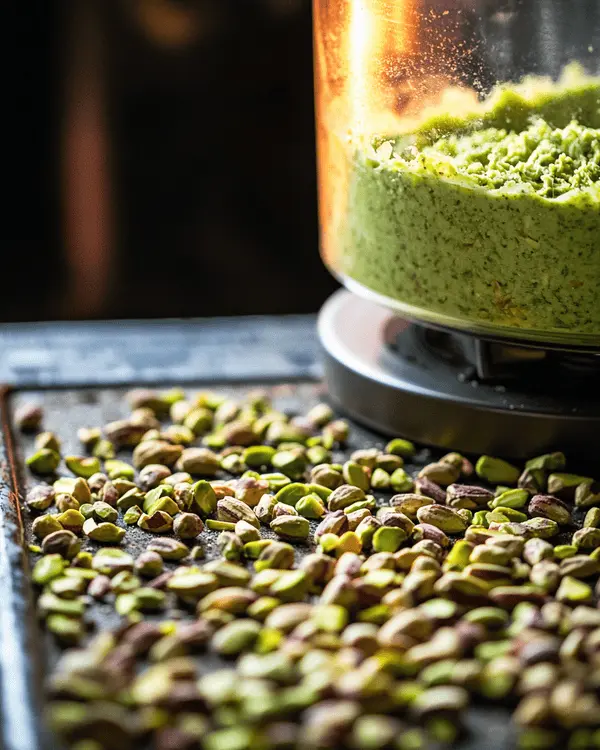
Step 1: Toast the Pistachios Perfectly
Preheat your oven to 325°F. Spread shelled pistachios in a single layer on a cookie sheet. This even distribution ensures uniform toasting.
Bake for 5-10 minutes until fragrant but not browned. Slivered pistachios need less time, while whole pistachios require a few extra minutes. The aroma should smell nutty and warm.
Pro Tip: Oops! I once burned an entire batch by walking away for 15 minutes. Set a timer and check frequently to avoid my mistake.
Detailed Toasting Technique: Position your oven rack in the center for even heat circulation. Avoid the top rack, which creates hot spots and uneven browning. Bottom racks may not provide sufficient heat activation.
Shake the pan gently halfway through toasting to ensure even color development. However, don’t open the oven door more than once, as temperature fluctuations affect consistency.
Visual and Sensory Cues: Properly toasted pistachios develop a slightly deeper green color without any brown edges. They should sound crisp when tapped together and release an intoxicating aroma that fills your kitchen. If you notice any browning, remove them immediately to prevent bitter flavors.
Altitude Adjustments: At elevations above 3,000 feet, reduce temperature to 315°F and increase time by 2-3 minutes. High altitude cooking requires these adjustments because lower air pressure affects heat transfer and moisture evaporation rates.
Step 2: Cool and Process Initial Breakdown
Remove pistachios from the oven and let them cool slightly. Hot nuts can damage your food processor blades and create uneven texture.
Transfer cooled pistachios to your food processor bowl. Process until they break down into fine powder. This stage takes about 2-3 minutes of pulsing.
Common Mistake: Don’t rush this step. Patience creates smoother butter later.
Cooling Science: Nuts above 140°F can create steam in your food processor, leading to uneven processing and potential motor strain. Wait until they’re comfortable to touch but still slightly warm for optimal oil release.
Processing Strategy: Start with 10-second pulses followed by 5-second rests. This prevents overheating and allows the motor to recover between cycles. Listen to your machine – if it sounds strained, take longer breaks.
Powder Stage Perfection: The ideal powder resembles coarse cornmeal with no large chunks visible. If you see pieces larger than peppercorns, continue pulsing until uniform. This foundation stage determines final texture quality significantly.
Step 3: Achieve Creamy Perfection
Continue processing for 5-10 minutes, scraping bowl sides regularly. The mixture transforms from powder to paste to smooth butter. If using a blender, use the tamper to keep nuts moving.
Add one teaspoon of pistachio oil if the mixture seems too thick. This helps achieve restaurant-quality smoothness without compromising flavor.
Sensory Indicator: The finished butter should coat the processor blade smoothly, similar to natural peanut butter consistency.
The Transformation Stages: Stage 1 (0-2 minutes): Powder clumps together forming a coarse meal Stage 2 (2-4 minutes): Mixture becomes paste-like and slightly sticky Stage 3 (4-6 minutes): Oils release creating a thick, chunky butter Stage 4 (6-8 minutes): Smooth, creamy texture develops Stage 5 (8-10 minutes): Final silky consistency achieved
Troubleshooting Common Issues: If your mixture becomes too thick and stops processing smoothly, add oil one teaspoon at a time. Conversely, if it seems too thin, continue processing without additions until oils redistribute properly.
Motor Protection Tips: High-powered processors can handle continuous operation, but standard models need rest periods. Process for 2 minutes, then rest for 1 minute to prevent overheating. This patience pays off with superior results and protected equipment.
Professional Techniques: Commercial nut butter producers use specialized stone grinders that create incredibly smooth textures. We can approximate these results by processing longer at lower speeds when possible. Some food processors offer speed controls that help achieve professional-quality smoothness.
Step 4: Final Seasoning and Storage
Once you achieve desired consistency, add salt to taste. Pulse once or twice to combine evenly.
Transfer finished pistachio butter to an airtight container. The butter keeps for one month refrigerated or can be frozen for extended storage.
Salt Selection Science: Fine sea salt dissolves quickly and distributes evenly throughout the butter. Kosher salt works but may leave small crystals that affect texture. Avoid iodized table salt, which can create metallic flavors that clash with delicate pistachio notes.
Texture Customization: For ultra-smooth butter, process an additional 2-3 minutes after adding salt. For slightly chunky texture, pulse briefly to maintain small pieces. Some people prefer completely smooth butter, while others enjoy subtle texture variations.
Storage Container Preparation: Sterilize glass jars by washing in hot, soapy water and air-drying completely. Any moisture can cause spoilage or texture changes. Fill containers leaving 1/2 inch headspace to allow for expansion during temperature changes.
Expert Tips and Variations
Storage Mastery: Refrigeration extends shelf life significantly. However, let butter come to room temperature before using for easier spreading.
| Storage Method | Duration | Best For |
|---|---|---|
| Room temperature | 1 week | Daily use |
| Refrigerated | 1 month | Longer storage |
| Frozen | 6 months | Bulk preparation |
Creative Variations:
Holiday Spiced Version: Add cinnamon, nutmeg, and vanilla extract for festive flavors. This variation pairs beautifully with holiday dessert recipes.
Chocolate Pistachio Butter: Fold in melted dark chocolate for decadent results. Meanwhile, this version works wonderfully in chocolate dessert applications.
Savory Mediterranean Style: Add rosemary and garlic powder for sophisticated appetizer spreads. Consequently, this pairs perfectly with artisan crackers and wine.
Regional American Twist: Incorporate bourbon and brown sugar for Southern-inspired flavors. This variation celebrates American culinary traditions beautifully.
Make-Ahead Strategy: Double the recipe and freeze portions in ice cube trays. Subsequently, thaw individual portions as needed for consistent convenience.
Batch Processing Benefits: Making larger batches proves more efficient and economical. Your food processor works more effectively with larger quantities, and you’ll have pistachio butter ready for weeks of enjoyment. Freeze extra portions in small containers for gift-giving opportunities.
Professional Storage Tips: Store butter in small containers rather than one large jar. This minimizes air exposure each time you use it. Additionally, small portions thaw faster and maintain better texture consistency.
Extending Shelf Life Naturally: Add a thin layer of neutral oil on top of the butter before sealing. This prevents oxidation and extends freshness significantly. Remove this oil layer before using, or stir it in for extra smoothness.
Advanced Techniques and Troubleshooting
Achieving Restaurant-Quality Results: Professional kitchens often use a two-stage process: initial grinding followed by refining. You can replicate this by processing until smooth, then chilling for 30 minutes before final processing. This technique creates incredibly smooth, professional-quality texture.
Fixing Common Problems:
Too Thick/Won’t Process: Add oil gradually, one teaspoon at a time. Sometimes switching to a smaller batch size helps overloaded processors. If completely stuck, add a tiny amount of warm water (1 teaspoon maximum).
Grainy Texture: Continue processing longer – some nuts require up to 15 minutes for complete smoothness. Ensure your processor blades are sharp; dull blades create uneven textures.
Oil Separation: This indicates over-processing or temperature fluctuations. Stir gently to reincorporate, then store in consistent temperatures. Natural nut butters separate more readily than commercial versions with stabilizers.
Bitter Flavors: Usually caused by over-toasting or using old nuts. Start over with fresh pistachios and lower temperature toasting. Quality ingredients make enormous differences in final flavor.
Motor Overheating: Take frequent breaks during processing. Some processors automatically shut off when overheated – wait 15 minutes before resuming. This protects your equipment and ensures optimal results.
Serving Suggestions and Pairings
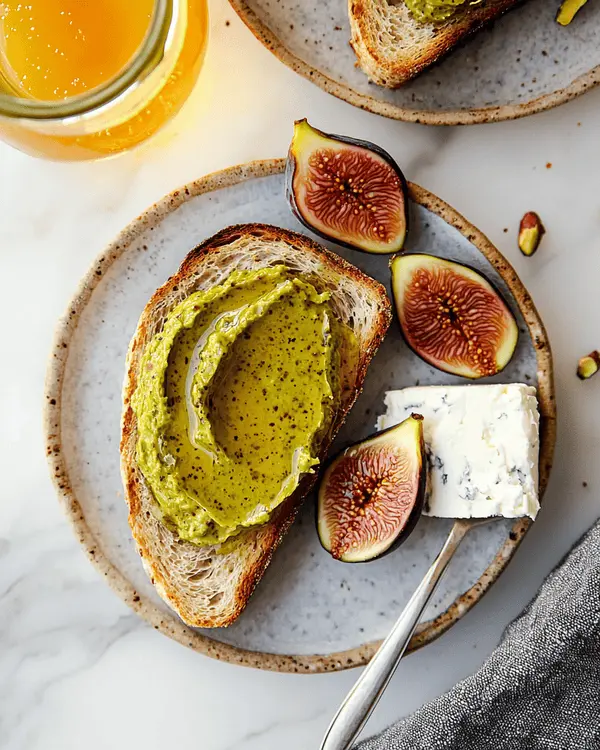
Pistachio butter shines in both sweet and savory applications. Spread it on warm sourdough toast with honey for breakfast perfection. Moreover, it creates stunning pistachio dessert combinations when layered with vanilla ice cream.
For entertaining, serve alongside fresh fruit and artisan crackers. The rich, nutty flavor complements sharp cheeses and crisp wines beautifully.
Perfect Pairings:
- Fresh figs and goat cheese
- Apple slices with cinnamon
- Dark chocolate and sea salt
- Baguette slices with prosciutto
Celebrity chef Ina Garten often emphasizes that simple ingredients shine when prepared with care. This principle applies perfectly to homemade pistachio butter applications.
Breakfast Applications: Transform ordinary morning routines with pistachio butter-stuffed French toast. The nutty richness pairs beautifully with maple syrup and fresh berries. Meanwhile, swirl it into Greek yogurt with honey for protein-packed parfaits.
Dessert Creations: Fold pistachio butter into whipped cream for elegant tart fillings. Use it as a base for homemade ice cream or gelato. Furthermore, it creates incredible flavor depth in chocolate truffles and macarons.
Savory Surprises: Middle Eastern cuisine frequently combines pistachios with lamb and rice dishes. Thin your butter with olive oil to create unique salad dressings. Additionally, it works wonderfully in cheese boards alongside dried fruits and nuts.
Seasonal Serving Ideas:
Spring: Pair with fresh strawberries and shortbread cookies for garden party elegance.
Summer: Create frozen popsicles by mixing with coconut milk and honey.
Fall: Combine with pumpkin spice and cream cheese for seasonal spreads.
Winter: Warm gently and drizzle over vanilla ice cream with candied orange peel.
International Inspirations: Italian gelaterias often feature pistachio flavors prominently. French patisseries use it in macarons and éclairs. Meanwhile, Middle Eastern desserts like baklava showcase pistachios beautifully. Draw inspiration from these traditions for your own creative applications.
Frequently Asked Questions
Pistachio butter starts with toasted pistachios processed until smooth. The key involves proper toasting, patient processing, and optional oil addition for ultimate creaminess. Temperature control and timing create the difference between good and exceptional results.
Creating homemade pistachio spread requires high-quality nuts, proper equipment, and technique. Toast pistachios at 325°F, then process until smooth while scraping sides regularly. Additionally, add salt and oil to achieve your desired consistency and flavor profile.
Pistachio butter contains only nuts and minimal additives, while pistachio cream often includes dairy, sugar, and stabilizers. Furthermore, butter maintains natural nut oils, creating richer flavor and healthier nutritional profiles compared to commercial creams.
Absolutely! Pistachio butter provides healthy fats, protein, and essential minerals that support overall wellness. However, it’s calorie-dense, so portion control matters. Two tablespoons contain approximately 180 calories with beneficial nutrients including vitamin E, magnesium, and potassium. The protein content helps with satiety, while healthy fats support heart health and nutrient absorption.
Commercial pistachio butter costs more because pistachios are expensive nuts requiring specific growing conditions. Additionally, processing equipment and small-batch production increase costs. Making it at home reduces expenses while improving quality significantly.
Moderate daily pistachio consumption offers health benefits including heart health support and protein intake. Nevertheless, stick to 1-2 tablespoons of pistachio butter daily as part of balanced nutrition. Consult healthcare providers for personalized dietary advice.
Conclusion: Your Pistachio Butter Journey Begins
Making homemade pistachio butter transforms your kitchen into an artisan food laboratory. The process teaches patience while delivering incredible results that surpass store-bought alternatives.
This recipe empowers you to control ingredients, save money, and create personalized flavors. Whether you prefer classic simplicity or bold variations, homemade pistachio butter elevates everything from morning toast to elegant desserts.
Try pairing your fresh pistachio butter with sparkling cider or craft coffee for the ultimate American comfort experience. Share your creations on social media and tag fellow food enthusiasts to spread the homemade love.
Remember that wooden spoon and oversized apron from grandma’s kitchen? This recipe continues that tradition of creating something special with your own hands.
Just like my grandmother’s wisdom about those “magical little gems,” pistachio butter carries the power to transform ordinary moments into extraordinary memories. Every jar you make connects you to centuries of culinary tradition while creating new stories for your own family.
The journey from whole pistachios to silky butter mirrors life itself – patience, technique, and quality ingredients combine to create something beautiful. Moreover, the satisfaction of mastering this skill builds confidence for tackling other culinary challenges.
Your Next Steps: Start with this basic recipe, then experiment with your own variations. Document your favorite combinations and share them with friends and family. Furthermore, consider making extra batches for holiday gifts – homemade pistachio butter in beautiful jars creates memorable presents that people treasure.
Building Your Culinary Legacy: Every time you make this recipe, you’re contributing to your family’s food story. Children remember the aromas, textures, and tastes of homemade foods long into adulthood. Therefore, invite them into the process and watch their excitement as pistachios transform into creamy butter.
Community Connection: Join online communities of nut butter enthusiasts who share tips, variations, and creative applications. The knowledge you gain from this recipe opens doors to understanding other nut and seed butters, expanding your culinary repertoire significantly.
Sustainable Practices: Making your own nut butters reduces packaging waste and supports sustainable food practices. You control the sourcing, processing, and storage, creating a more environmentally conscious choice that tastes incredible.

How to Make Pistachio Butter
Ingredients
Equipment
Method
- Toast the Pistachios
- Preheat oven to 325°F. Spread pistachios on a baking sheet in a single layer. Toast for 5–10 minutes until fragrant but not browned. Shake pan halfway through.
- Cool and Break Down
- Let pistachios cool slightly (not hot to the touch). Transfer to food processor and pulse for 2–3 minutes until a fine, uniform powder forms.
- Process to Creamy Butter
- Continue processing 5–10 minutes, scraping down sides. Add pistachio oil if needed for smoother consistency. Process through five stages until silky.
- Season and Store
- Add sea salt to taste and pulse to combine. Transfer to airtight container. Refrigerate up to 1 month or freeze for 6 months.
- Calories: ~170 per 2-tablespoon serving (based on plain butter with no add-ins)

